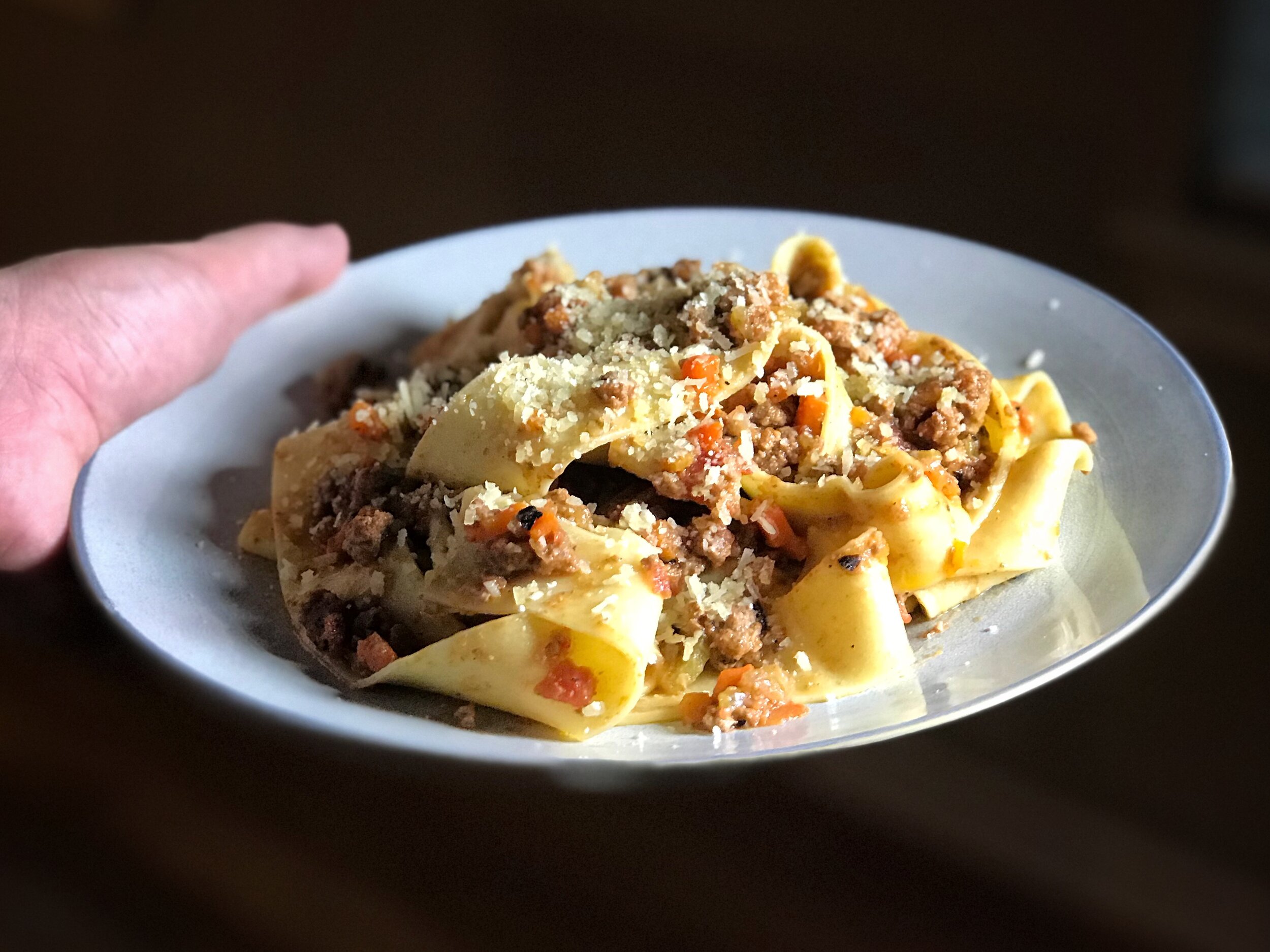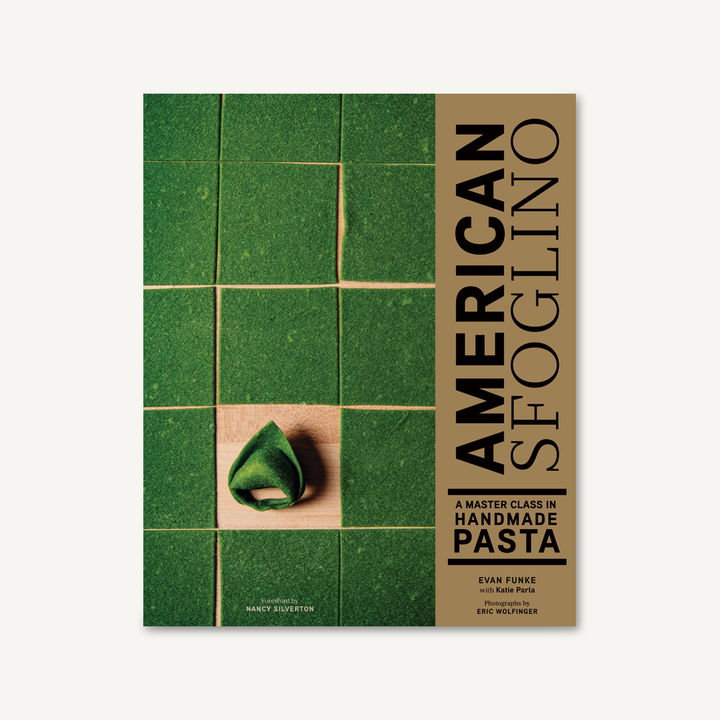Last year, when L.A.’s handmade pasta genius Evan Funke published his cookbook American Sfloglino: A Master Class in Handmade Pasta, I couldn’t wait to get my hands on it. His then two-year-old Venice pappardelle palace, Felix, had pasta-loving Angelinos swooning. Chef Funke was getting big-time buzz with the book, whose forthright hashtag, #fuckyourpastamachine, said everything you needed to know about its handmade approach.
The book has since been nominated for a James Beard Award for its gorgeous photography, by Eric Wolfinger — whose beautiful how-to shots are at once sensuous and highly instructive; the pics of Funke’s finished plates are almost painfully attractive.
Wylie had just moved in with us post-college to start a job search, and when the book arrived in the mail, we devoured it together. If ever there was a book to appeal to the current Gen-Z zeal for extreme DIY immersion, this was it.
We knew immediately what we had to do. We had to attempt the book’s two holy grails: sfloglia all’uovo (egg dough, for pasta) and ragù della Vecchia Scuola, the old-school meat sauce bolognese that, once you have procured all the ingredients and equipment, is a seven- or eight-hour project.
We blocked off not just a Saturday, but the whole weekend. For the ragù — which Funke learned at La Vecchia Scuola Bolognese in Italy (which is also where he learned to make pasta) — we had to purchase a meat grinder. (We bought an inexpensive cast-iron manual, hand-crank number.) I already had a food mill, suggested to make the passata di pomodoro (tomato sauce) that is another ingredient in the ragù. So a half-hour plus for that before you can even start the ragù.
The ragù recipe calls for grinding together beef chuck, pork shoulder, pancetta, prosciutto and mortadella — nearly four pounds in total. Plus five ounces of strutto, which is pork fat. It yields two and a half more quarts of sauce than you need for the recipe, which is a good thing, as the recipe is so time consuming.
Gathering the ingredients was its own adventure, and then the grinding, etc., followed by five to seven hours of cooking time. We had a grand time in the kitchen, Wylie and I.
The sauce was outrageously good, profoundly delicious. The transformation — after hours and hours and hours of simmering — was so striking, its depth extraordinary. At some point, it seemed like it all just melted together. It wasn’t ready, and then it was. Patience was an important ingredient.
It was also so rich that when we looked at what was left over in the fridge the next day, we were shocked by the white of all that strutto. Incredible that we had ingested that much fat. No wonder it was so good. Round two, the leftover ragù with dried pasta, was also profoundly delicious, but frankly, I wonder how long it’ll be before I’m moved to devote another weekend to making that sauce again.
As the ragù simmered that Sunday we made the pasta. I’ve owned a pasta machine — the old-fashioned, hand-cranked Atlas-type — since I was 19, and used it regularly for years, so the prospect of making dough and rolling and cutting pasta was not daunting. I’ve long understood that the dough requires a half-hour or 45-minute rest before rolling so the glutens relax, in order to get tender noodles.
With Funke, the only equipment requirements are a rolling pin, a knife and a scale; a bench scraper and a spray bottle of water are handy. You also need a very large board for rolling out the dough into an immense, round sfoglia.
Once you dive in, there is a lot of kneading and shaping and several hours of resting, and quite a lot of super-precise rotating and rolling of dough — whose desired thickness Funke measures in the thickness of a stack of Post-It notes (9 Post-It notes for pappardelle, 4 for tagliatelle). And then curing, which is more resting, and then cutting. We probably should have attempted pappardelle first, but we wanted to make Tagliatelle al Ragù della Vecchia Scuola, the book’s flagship recipe.
Pappardelle made from a simplified method inspired by American Sfloglino
The resulting pasta, I have to say, was outstanding. Was it blows-it-away better than what I’d always made with my machine? Um, no. Better, but not that much better. If we are going to be painfully honest.
However, I really enjoyed the process. It’s just wonderful to knead the dough by hand, and roll it out into a beautiful, thin, giant round (even though it takes forever). Few cooking projects I’ve attempted have been that satisfying. So you know what? It has now become my preferred way to make pasta. I’m sure I’ll use my machine again, but only if I’m short of time.
Too late to say long story short, but here comes the payoff. When the Covid-19 crisis first struck, and there was a run on dried pasta, I wrote a story for my local paper, The Dallas Morning News about how to make fresh pasta without a pasta machine — using a much simplified version of Funke’s method. We couldn’t tell the difference on the plate; it was wonderful.
I wanted to offer a recipe for a ragù bolognese as well, but now was not the time for Funke’s Vecchia Scuola sauce, for many reasons — prime among them the long list of special ingredients, which were just not possible to procure. Instead I turned to the late great Marcella Hazan’s seminal 1973 The Classic Italian Cookbook, to page 127, to be precise: Meat Sauce Bolognese Style.
Hazan’s ragù differs from Funke’s in a few ways. First, Hazan’s calls for nothing more exotic than ground lean beef; its other ingredients are staples, easily gotten. Second, one of the ingredients is milk, so it’s a different type of ragù bolognese. Third, Funke has you put the celery, carrot and onion through the meat grinder. And finally, Hazan’s requires only 3 ½ to 5 hours of simmering, compared to Funke’s 5 to 7.
I tweaked Hazan’s just a little, for convenience and yield’s sake; notably Hazan’s called for ¾ pound of ground beef, which I upped to 1 pound, and she called for 2 cups of canned tomatoes, which is slightly more than a regular can and a lot less than a large can; I evened it out to one 14.5-ounce can for my adaptation.
The recipe, striking in its simplicity, doesn’t look like much. But putting it together is just the kind of lazy, laid-back slow cooking that seems so soothing right now, and enveloping the tender, floppy handmade pappardelle in Hazan’s ragù — deep and soulful and tender as well — was a pure and profound pleasure. I highly recommend it.




